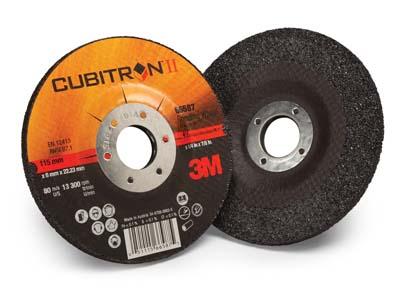
3M Abrasive Systems introduces 3M Cubitron II Bonded Abrasive Grinding and Cut-Off Wheels. With Cubitron II abrasives, users get precision-shaped grain technology that cuts faster, stays sharper longer, and requires less pressure than conventional grinding and cut-off wheels, according to the company. In addition, the abrasives can help reduce operator fatigue and increase productivity.
"This technology is the most important change in abrasives in the last 20 years," said Dan Cunningham, Director Sales and Marketing, 3M Abrasive Systems. "We've utilized 3M's core technology platforms to create products that enable customers to produce more each day, while also helping reduce the impact on their workers."
The company reports that conventional ceramic abrasive grains are irregular in shape, and work by "plowing" through metal, which can cause heat buildup, slower cutting and shorter life. But the precision-shaped grains in Cubitron II grinding wheels continuously fracture to form sharp points and edges. This technology helps Cubitron II abrasives slice cleaner and faster, stay cooler, and last longer than conventional wheels.
Cubitron II abrasives offer performance that surpasses that of traditional grinding wheels made with aluminum oxide, alumina zirconia or ceramic grain. Competitive products reportedly require up to three times the amount of pressure to match the cut of Cubitron II abrasives. With the advantages of 3M's technology, operators are subjected to less wear and tear, and can remove more material with the same amount of effort. It all adds up to improved productivity, achieved in a way that is good for the business and for workers.
"Operators have a tough job, so it's our hope that 3M's new Cubitron II bonded abrasives can make it easier on them, while still performing exceptionally on the shop floor," continued Cunningham.
A wide variety of industries stand to benefit from these advancements, including ship building; structural steel; general metal fabrication; oil and gas; and agriculture, industrial and construction machinery. Cubitron II abrasives offer potential for operators in all of these fields to easily increase efficiency.
Contact Details
Related Glossary Terms
- abrasive
abrasive
Substance used for grinding, honing, lapping, superfinishing and polishing. Examples include garnet, emery, corundum, silicon carbide, cubic boron nitride and diamond in various grit sizes.
- aluminum oxide
aluminum oxide
Aluminum oxide, also known as corundum, is used in grinding wheels. The chemical formula is Al2O3. Aluminum oxide is the base for ceramics, which are used in cutting tools for high-speed machining with light chip removal. Aluminum oxide is widely used as coating material applied to carbide substrates by chemical vapor deposition. Coated carbide inserts with Al2O3 layers withstand high cutting speeds, as well as abrasive and crater wear.
- bonded abrasive
bonded abrasive
Abrasive grains mixed with a bonding agent. The mixture is pressed to shape and then fired in a kiln or cured. Forms include wheels, segments and cup wheels. Bond types include oxychloride, vitrified, silicate, metal, resin, plastic, rubber and shellac. Another type of bond is electroplated, wherein the abrasive grains are attached to a backing by a thick layer of electroplated material.
- fatigue
fatigue
Phenomenon leading to fracture under repeated or fluctuating stresses having a maximum value less than the tensile strength of the material. Fatigue fractures are progressive, beginning as minute cracks that grow under the action of the fluctuating stress.
- grinding
grinding
Machining operation in which material is removed from the workpiece by a powered abrasive wheel, stone, belt, paste, sheet, compound, slurry, etc. Takes various forms: surface grinding (creates flat and/or squared surfaces); cylindrical grinding (for external cylindrical and tapered shapes, fillets, undercuts, etc.); centerless grinding; chamfering; thread and form grinding; tool and cutter grinding; offhand grinding; lapping and polishing (grinding with extremely fine grits to create ultrasmooth surfaces); honing; and disc grinding.
